想称霸电动汽车行业?先得跨过中国这道坎
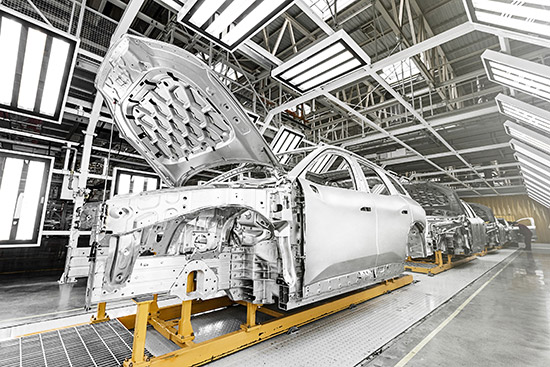
|
位于上海西边一处单调的工业区里,多家工厂每年生产成千上万辆汽油车,还有变速器和发动机,全世界最大的汽车制造商正在此处加紧建造新型工厂,生产与以往不同的汽车。新工厂占地74英亩,新型装配线传送带由塑料制成,不再是传统的钢制或木制,系统配置起来成本更低,汽车的外形和布局可以比以前更频繁地做大规模调整。此外,工厂将配备红外摄像机,监控之前不必大规模存储,但现在必须大量存放的巨型电池库存。每块巨型电池的体积几乎相当于两口棺材并排,而且存在令人不安的起火隐患。 上海的新工厂并非渐进式产业调整,而是大众汽车的一场豪赌,目标是争夺电动汽车时代的霸主地位。“大众”的品牌名称“Volkswagen”是德语,字面意思是“人民的汽车”,创立80年来,“人民”一直都是指欧洲人或美国人,汽车指的是燃油车。但现在,大众最大的市场是中国,在新出台环保法规的刺激下,公司决心重新打造为主要生产电动汽车的公司,新建的上海工厂也因此变成大众努力求生的基地。等到明年正式启动生产,该处将成为大众“在全球最现代化的工厂”,大众在中国与上汽集团成立的合资企业的负责人弗雷德·舒尔茨表示。上汽集团是中国最大的国有汽车制造商。舒尔茨在大众工作多年,曾经在大众旗下的奥迪部门负责运动型多用途车和跨界型车,主要是Q7和Q8等燃油车,也有电动款E-tron。舒尔茨谈起大众时表示,从现在开始,“增长应该来自于电动汽车。” 在全球经济中,化石燃料时代的巨人们争先恐后地适应新现实,即清洁能源替代污染能源的经济性不断提高。电力和石油生产商都想驰骋在可再生能源浪潮之巅,而不是被浪潮冲垮。银行努力支持其投资组合,应对气候变化造成的损失。汽车制造商则身处最可怕的十字路口。电动汽车的兴起正在重新定义汽车制造,车上由一台大型发动机变成多台小型发动机;电池代替燃油箱;变速箱变成空前强大的软件系统。如果成熟的汽车制造商做不到主动适应,而且是迅速适应的话,长期以来被视为标志性资产的企业基础设施可能最后只是难以承担的搁浅成本。 |
In a drab industrial zone of western Shanghai, amid factories that each year crank out hundreds of thousands of gasoline-powered cars, transmissions, and engines, the world’s largest automaker is racing to finish a new sort of plant, one that will produce a car unlike any it has made before. The 74-acre facility will have a newfangled assembly-line conveyor belt made of plastic instead of the typical steel or wood—a system that should be cheaper to reconfigure on the fly in order to manufacture cars whose shapes and layouts are likely to change more frequently and radically than any model the company has previously built. And the plant will be decked out with infrared cameras to monitor the safety of stockpiles of a component the company hasn’t before had to deal with in large volume: enormous batteries—each nearly as big as two coffins side by side—that have a nagging propensity to ignite. What’s happening here in Shanghai is no incremental industrial tweak. It’s Volkswagen AG’s bet-the-corporation bid for supremacy in the electric-car age. “Volkswagen” translates as “the people’s car,” and for much of the eight decades of VW’s existence, the people were understood to be European or American and the cars to run on petroleum. But now VW’s biggest market is China, and the company, squeezed by new environmental mandates, has resolved to remake itself largely as a producer of electric vehicles, or EVs. Which makes this new Shanghai plant the forward base in the fight of VW’s life. When it starts producing electric vehicles next year, it will be VW’s “most modern factory worldwide,” says Fred Schulze, who heads production in Shanghai for VW’s joint venture in China with SAIC Motor, the Shanghai-based firm that is China’s biggest state-owned automaker. Schulze, a VW veteran, previously oversaw production of sport-utility and crossover vehicles from VW’s Audi unit—mostly gas-guzzlers such as the Q7 and Q8 but also the electric E-tron. From now on, Schulze says of VW, “our growth should be from EV cars.” All across the global economy, titans of the fossil-fuel era are scrambling to adapt to an existential shift: the soaring economic viability of clean alternatives to dirty energy. Electricity and oil producers are struggling to ride—¬rather than be crushed by—a renewable-¬energy wave. Banks are trying to shore up their portfolios against losses induced by climate change. Automakers, though, are at a particularly scary fork in the road. The rise of electric vehicles—machines with multiple small motors instead of one big engine; with batteries instead of a fuel tank; with unprecedentedly extensive software systems instead of a transmission—is poised to redefine car making. If established automakers don’t adapt, and fast, the corporate infrastructure they have long seen as a signature asset may prove instead an insupportable stranded cost. |
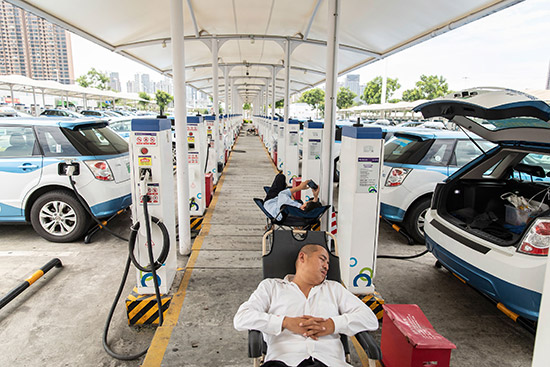
|
现在宣布燃油汽车时代结束还为时过早。根据能源数据公司Wood Mackenzie的数据,截至6月30日的六个月里,在全球销售的97%新车引擎盖下只有燃油发动机。但现在要说电动汽车迅速赶上也不算太超前。事实上,电动汽车的销售额已经超过了许多专家的预期。Wood Mackenzie的数据显示,全球范围内,乘用电动汽车(包括没有燃油发动机的纯电动汽车)和“插电式混合动力电动汽车”(通过燃油发动机增强电池系统)的总销量从2018年上半年到2019年上半年跃升了47%,达到110万辆。销量激增由多种因素共同推动:一是成本下降和技术进步,尤其是电池方面;二是充电基础设施日益便利,尤其在大城市;另外还有政府的大力支持。 在汽车工业转向电动汽车的过程中,胜负很大程度上取决于谁在中国取得胜利。中国城市里的空气有污染,而且人们都热爱SUV,但短短几年里,中国已经成为全世界最大的电动汽车市场。中国电动汽车的崛起主要是因为政府补贴和强制性政策的有效组合,相关政策既受当地环境问题的影响,也因为政府有意在全球蓬勃发展的技术中抢占有利地位。Mackenzie的数据显示,截至今年6月30日,中国在全球插电式混合动力汽车和纯电动汽车销量中占54%,美国的份额仅为16%。 这还只是开始。中国汽车工程师协会表示,到2030年,中国40%的乘用车销量都会是纯电动或插电式混合动力汽车。鉴于未来十年里电动汽车行业有望保持增长,实现该目标并不遥远。为了支持行业增长,中国主要城市里的电动汽车充电站如星巴克一样涌现,有些大到可以同时为数百辆汽车充电。现在中国有数百家公司生产电动汽车。随着中国汽车市场整体疲软,政府曾经推动电动汽车初创企业迅猛发展的补贴撤销,行业大洗牌可能即将来临。但趋势显而易见:20世纪的中国在燃油汽车方面落后于世界,21世纪几乎肯定会在发展电动汽车方面领先于世界。 结果是中国的电动汽车比赛节奏快,经济风险大,而且人人都有希望赢。“有点像当年的加州的淘金热。”大众中国业务的主管冯思翰表示。说这话时,他正坐在位于北京豪华的大众中国总部大楼空调会议室里,桌上摆放着印有大众品牌标识的面巾纸。 今年夏天,我花了不少时间跟中国电动汽车行业的主要竞争者接触。当中包括有些历史的品牌,也有傲慢的新贵,还有大众之类的资本雄厚的西方公司。彭博社新能源金融称,比亚迪是几年来全世界最大的电动汽车制造商,直到最近特斯拉才追上。沃伦·巴菲特旗下的伯克希尔-哈撒韦持有比亚迪约8%的股份。还有一直在亏钱但技术上颇有亮点的蔚来,目前在生产装有各种小配件的电动SUV。当然还有总部位于加州的行业标杆特斯拉,由脾气善变的埃隆·马斯克创立,特斯拉汽车漂亮而昂贵,基本上可以说开创了全球电动汽车市场。特斯拉拒绝为本篇报道发表评论,今年早些时候,特斯拉在上海的大型电动汽车工厂破土动工,与大众正在建设的新工厂遥遥相对。 对于美国和欧洲担心中国工业霸权的人来说,电动汽车是中国争夺市场主导地位的行业代表。不过这一次,中国的影响力可能不会那么明显。因为汽车体积很大,运输成本也很高,不像手机或太阳能电池板,汽车制造很可能主要还是本地活动,然后在全球主要市场开设工厂。尽管中国不太可能实现全球电动汽车制造业高度集中,却正在定义全球电动汽车市场的发展方式,即制定道路规则。在许多行业中,中国落后于美国和欧盟。但在电动汽车领域,中国在一些西方大型跨国公司帮助下,逐渐将美国和欧盟甩在身后。 |
It’s far too soon to declare the end of the internal-combustion era. In the six months ended June 30, according to Wood Mackenzie, an energy-data firm, 97% of all new passenger cars sold globally had only an oil-burning engine under the hood. But it’s not too early to see that electric cars are coming on fast. Indeed, sales are shooting up beyond many supposed experts’ wildest projections. Globally, according to Wood Mackenzie, combined sales of passenger EVs—including full-electric vehicles, which have no combustion engine, and “plug-in hybrid-electric” vehicles, which augment their battery system with a combustion engine—jumped 47% from the first half of 2018 to the first half of 2019, to 1.1 million. The surge is being driven by a combination of factors: declining cost and improving technology, notably for batteries; increasingly convenient electric-charging infrastructure, particularly in large cities; and hefty government support. Who wins and loses globally in the auto industry’s pivot to an electric-car future will depend largely on who triumphs in China. The country, home to polluted urban skies and a population gaga for SUVs, has become, in just the past few years, by far the biggest electric-car market in the world. Owing to a potent mix of government subsidies and mandates—policies driven both by local environmental concerns and by an intent to dominate a burgeoning global technology—China accounted for 54% of the world’s sales of plug-in-hybrid and full-electric cars in the year ended June 30, Wood Mackenzie says. The U.S. share: 16%. But that’s just the start. China’s Society of Automotive Engineers has said 40% of passenger-vehicle sales in the country should be full electrics or plug-in hybrids by 2030. That’s not far off in an industry that plans in decade-long increments. To support the push, electric-car charging stations, some big enough to charge several hundred cars at a time, are popping up across major Chinese cities like so many Starbucks. Hundreds of firms in China are today manufacturing electric cars. A shakeout is probably in the offing, as China’s overall auto market softens and Beijing dials back the subsidies that have spurred the proliferation of EV startups. But the trend is clear: The country that trailed the world during the 20th century at developing cars that burn oil seems all but certain to lead it in the 21st in developing cars that hum on wired juice. The result is an electric-car race in China that’s fast-paced, financially risky, and anyone’s to win. “It’s a little bit like the Gold Rush in California,” says Stephan Wöllenstein, the head of VW’s China business, who, as he offers this analysis, is sitting in an air-conditioned conference room, a box of VW-branded facial tissue on the table, on the top floor of the automaker’s tastefully appointed China headquarters tower in Beijing. This summer, I spent some time in China with a few of the leading contenders in the electric-car race. They range from long-¬established Chinese auto brands to brash upstarts to well-capitalized Western companies like VW. There’s BYD, which according to Bloomberg New Energy Finance was the world’s largest maker of EVs for several years until Tesla recently overtook it—and in which Warren Buffett’s Berkshire Hathaway owns about an 8% stake. There’s Nio, a money-losing but technologically showy company that is producing gadget-laden electric SUVs. And then, of course, there’s Tesla, the California-based icon founded by the mercurial Elon Musk, whose pretty and pricey cars essentially created the global electric-vehicle market. Tesla, which declined to comment for this story, broke ground earlier this year on a colossal electric-car factory on the other side of Shanghai from the spot where VW is building its new plant. To those in the U.S. and Europe inclined to fret about Chinese industrial hegemony, EVs represent the latest tech-centric industry that China has targeted to dominate. But this time China’s influence is likely to play out more subtly. Because cars are big and thus expensive to ship—unlike, say, mobile phones or solar panels—manufacturing them is likely to remain a largely local activity, with factories in major markets around the globe. But while China is unlikely to centralize the world’s electric-car manufacturing, it is defining how the global EV market develops—that is, setting the rules of the road. In many industries, Beijing has trailed Washington and Brussels. In the electric-car sector, Beijing, aided by some of the biggest Western multinationals, is leaving Washington and Brussels in the dust. |
****
|
中国的产业战略从来不是一个人推动的结果。欧阳明高却堪称中国电动汽车发展的技术之父。他的办公室位于堪称中国版哈佛大学的清华大学汽车研究所顶层,地上铺着地毯,他花了超过25年协助指导主要由政府资助的研发运动,正是这场运动形成了今天的电动汽车热潮。 一个闷热的周六早晨,我见到了欧阳明高。他晚到了一会,刚从一场会议赶过来,会上他帮助制定战略进一步增加北京道路上的电动汽车数量。他的研究所楼梯间里摆满了汽车工业先驱的肖像,卡尔·本兹、鲁道夫·迪塞尔、亨利·福特、尼古拉斯·奥托,还有孟少农,照片下面的牌子上写着“新中国汽车工业创始人”。 1993年欧阳明高来到清华时,中国刚刚启动电动汽车研发项目。多年来,投入不断增加。2008年,由于中国在北京奥运会上展示了500辆国产电动汽车和公共汽车,行业重要性大为提升。更重要的是全球金融危机来袭。危机的直接后果之一是奥巴马政府2009年的经济刺激计划,其中包括投资数十亿美元支持美国清洁能源产业。 美国政府的大规模投资计划引起了中国的注意,2009年,中国政府开展了欧阳明高所称的“高层战略讨论”,研究中国应该如何推进清洁技术发展。中国的最高决策机构国务院最终宣布了九大“战略”产业,其中之一便是电动汽车。政府开始郑重发放补贴,包括对电池制造商、汽车制造商和电动汽车购买者的巨额补贴,对技术发展最快的公司鼓励力度更大。 但中国在电动汽车方面的努力并不仅仅为了推动技术发展,还涉及控制消费者行为。在北京、上海和深圳等中国大城市里,政策严格限制新燃油车牌照发放,获得电动汽车牌照要容易得多。中国也利用了欧阳明高认为中国比美国更适合大规模推广电动汽车的特点。首先中国的电力相对便宜。其次,由于电动摩托车普及,人们对电动汽车的广泛应用具有长期认知。而且,人们长途出行主要依靠国家出资修建的高铁,短途出行时格外倾向于自驾,为短途自驾修建充电站基础设施比长途旅行容易得多。欧阳明高说,出于各种原因,“我认为美国不是最适合电动汽车发展的地方,中国最适合。” |
Industrial strategy in China is never the result of a single person. But, as much as anyone else, Ouyang Minggao is the technological father of China’s electric-car push. From his carpeted office on the top floor of an automotive institute at Tsinghua University, essentially China’s Harvard, Ouyang has spent more than a quarter century helping steer the largely government-funded research-and-development campaign that has resulted in today’s EV boom. I meet Ouyang there on a sweltering Saturday morning. He’s running late, rushing from a session at which he helped strategize about further boosting the number of electric cars on the road in Beijing. His institute’s stairwells are lined with black-and-white photos of auto industry pioneers: Karl Benz, Rudolf Diesel, Henry Ford, Nikolaus Otto, and Meng Shao¬nong, who—a plaque below his photo notes—was “the founder of the Chinese automobile industry.” When Ouyang came to Tsinghua in 1993, China had just launched an electric-vehicle R&D program. Over the years, spending rose. Then, in 2008, things got a lot more serious. That year, China showed off 500 domestically made electric cars and buses at the Beijing Olympics. More significantly: The global financial crisis hit. One direct result of the meltdown was the Obama administration’s 2009 economic-stimulus plan, which included billions of dollars in support for U.S. clean-energy industries. That spending plan caught the attention of Beijing. And it led, in 2009, to what Ouyang describes as a “strategic discussion at high levels” in the Chinese government about how the country should proceed with its own clean-technology push. China’s State Council, the country’s top policymaking body, ultimately announced nine “strategic” industries, one of which was electric cars. Government subsidies began to flow in earnest and included hefty subsidies for battery makers, automakers, and electric-car buyers—with bigger awards to the companies that advanced technology most rapidly. But China’s electric-car effort hasn’t just been about pushing tech boundaries. It also has involved manipulating consumer behavior. In big Chinese cities such as Beijing, Shanghai, and Shenzhen, municipal policies have severely constrained people’s ability to obtain license plates for combustion cars—but have made it easy for them to get plates for electric vehicles. China has also capitalized on several characteristics that Ouyang contends make it more suitable than the U.S. for large-scale electric-car use. China has relatively cheap electricity. It has a history of widespread electric-vehicle use, in the form of scooters. And, thanks largely to extensive state-sponsored high-speed rail for distant journeys, it has a consumer driving pattern that skews heavily toward short city trips, which are easier than long rides to build an infrastructure of car-charging stations around. For all these reasons, Ouyang says, “I think the United States is not the best application” for electric cars. “China is.” |
****
|
如果说世界上有座城市可以当成电动汽车未来的缩影,那就是深圳。一个闷热的夜晚,我离开机场航站楼,跟几百名汗流浃背的乘客一起排队叫出租车,发现了让我惊讶的事实。排队的出租车都是电动的,而且全是同一款车型:总部位于深圳的比亚迪制造的两厢车。 比亚迪中文里的“比”在英语里与“蜜蜂”同音,确实能够体现出中国电动汽车企业从偏技术的科学项目迅速发展为严肃行业的感觉。比亚迪成立于1995年,刚开始是诺基亚和摩托罗拉等西方品牌手机电池的制造商。2002年,比亚迪在香港证券交易所上市。2003年开始销售燃油汽车,2010年开始卖电动汽车,包括出租车和公共汽车。比亚迪早期的电动汽车只是汽油汽车的改进版。2014年前后,比亚迪的研发部门开始设计全新的汽车架构,汽车行业称之为“平台”,通过从头开始设计优化电动汽车的特定属性。比亚迪称之为“E平台”研发的汽车在去年开始进入市场。 比亚迪也获得了本地政府的大力支持。深圳出租车监管机构要求本地出租车公司改用电动汽车,才能维持运营许可证,而且过去几年发放了约5.1亿美元的补贴,让电动汽车的价格降到与燃油车持平,出租车监管机构的副主任曾浩(音译)表示。如今深圳的21000辆出租车里只有100辆不是电动汽车,均由深圳本地的比亚迪制造。 如果有谁认为中国造的电动汽车是咔咔作响的小破车,可以去坐比亚迪新车兜风体验一下。乘坐比亚迪确实比不上电动汽车之王特斯拉Model S的极品体验,但价格也低得多,Model S在中国的标价超过10万美元。E平台研发的顶级车型是唐,补贴后标价约为5.1万美元。E平台较为低端的基本车型补贴后价格约为8500美元。 |
If one city on the globe epitomizes an electric-car future, it’s Shenzhen. The reality jars me as soon as I exit the airport terminal on a steamy evening and, along with a few hundred other sweaty people, get in line for a taxi. Every cab in the queue, which stretches as far as I can see, is electric. What’s more, each is the same model: a hatchback made by Shenzhen-based BYD. The growth of BYD—in Chinese, “bee-YA-dee”—epitomizes the dizzying speed with which China’s electric-car enterprise has matured from a geeky science project into a dead-serious industry. Founded in 1995, it early on was a contract maker of cell phone batteries for Western brands such as Nokia and Motorola. BYD went public on the Hong Kong Stock Exchange in 2002. It began selling combustion cars in 2003 and electric vehicles—taxis as well as buses—in 2010. Its early EVs were just modified versions of gas-powered cars. But around 2014, BYD’s R&D department began designing an all-new vehicle architecture—known in the auto business as a “platform”—in an effort to optimize the particular attributes of the electric vehicle by designing one from the ground up. Cars based on what BYD calls this “E-platform” began hitting the market last year. BYD has benefited mightily from hometown government support. The agency that regulates Shenzhen’s taxis required that local taxi companies switch to EVs to maintain their permits to operate—and it doled out subsidies over the past few years totaling about $510 million to bring the price of each EV taxi down to that of a comparable combustion model, says Zeng Hao, deputy director at the agency. Today, all but about 100 of Shenzhen’s 21,000 taxis are electric cars—all built, naturally, by Shenzhen’s own BYD. Anyone who assumes a Chinese electric car is a rattling econobox might want to take one of BYD’s new models for a spin. It lacks the it’s-good-to-be-king ride and feel of that crown jewel of the EV realm, the Tesla Model S. But it also lags the Model S’s China sticker price, which is upwards of $100,000. Loaded, the E-platform’s top model, the Tang, has a sticker price of about $51,000, after subsidies. A basic BYD model at the E-platform’s lower end can be had, after subsidies, for about $8,500. |
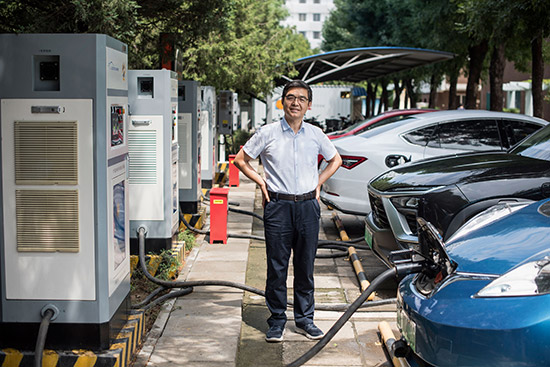
|
比亚迪的领导层对国内外的新竞争者并不太担心。“我们信心十足。”比亚迪负责乘用车研发的高级副总裁廉玉波表示。他指出,比亚迪在电动汽车领域比竞争对手都长。“我们掌握了所有技术。” 在各项技术当中,有一种电子开关,看起来不起眼,却对电动汽车的控制至关重要,叫绝缘栅双极晶体管(IGBT)。大多数汽车制造商向零部件供应商购买IGBT。随着电动汽车需求激增,IGBT市场出现短缺。比亚迪却不会受短缺限制,因为距离深圳东北700英里的宁波市,比亚迪拥有自己的IGBT工厂,隶属于比亚迪第六事业部。 我们说话的时候,廉玉波还逗我说当天下午晚些时候比亚迪将宣布一件大事。几个小时后,新闻出来了:比亚迪和丰田将联手制造丰田品牌的电动汽车,2025年将进军中国市场。这只是比亚迪与外国汽车制造商达成交易的最新一笔。过去五年,比亚迪与梅赛德斯-奔驰的德国母公司戴姆勒成立的合资企业一直在制造电动汽车,主要销往中国,品牌名为腾势。 不过,比亚迪并不满足于为外国品牌制造销往中国的电动汽车,而是一心渴望变成全球知名的电动汽车品牌。这就是为何2016年廉玉波从意大利请来大众旗下的设计工作室的沃尔夫冈·艾格,艾格曾经在奥迪担任设计总监。 我跟艾格见面的地点在比亚迪为他建的全新设计工作室大厅。艾格不像廉玉波一样朴素,穿着偏欧洲风格:棕色绒面运动鞋、时髦的紧身蓝色斜纹棉布裤、白色衬衫,还有剪裁考究的窗型格蓝色运动外套,格外映衬出瞳孔的颜色。我问他衣服在哪里定做时,他咧嘴一笑,带着理所应当的口气答道:“意大利。” 艾格说,离开大众汽车加入比亚迪其实非常简单。“在我看来,打造未来电动汽车品牌很有吸引力。”他补充道,“对我的职业生涯来说是锦上添花。”自从艾格加入,比亚迪在洛杉矶建立了附属设计工作室,离公司为美国生产电动公共汽车的工厂所在地加州兰开斯特不远。目前,比亚迪的全球设计团队已经从120人增加到200人,计划扩大到300人。艾格聘请的业内顶尖专家包括法拉利的前外观设计主管,以及曾经常驻意大利科莫的梅赛德斯-奔驰高级设计工作室前主管。他说,两人选择加入的原因跟他一样:“设计师在这里有机会增进认识并影响未来。” 艾格表示,在刚加入公司时,比亚迪的汽车设计“极为普通”,“没有感情”。他希望打造出“比如说结合德国科技感、意大利跑车感,再融合中国文化”的全球品牌。他运用的关键中国元素是龙,象征着力量和好运。全新设计的比亚迪新款电动汽车中有无数向龙致敬的元素,尤其是车前脸。他希望前灯让人联想到“龙的眼睛”,格栅让人想到“龙的嘴”,其间的铬或灯饰让人想到“龙的胡子”。 听起来有点梦幻,艾格随后解释说,类似的设计在燃油汽车上不可能应用。在比亚迪的设计中,龙的眼睛,也就是前灯在视觉上更为突出,因为引擎盖向下倾斜的角度很陡也很紧。在装配发动机的汽车上不可以,因为发动机需要前部轮廓更高,还需要进气孔。他说,在比亚迪,“燃油车只能跟在后面。现在电动汽车才是领导者。” |
The company’s leadership doesn’t appear overly worried about the new competition at home and from abroad. “We feel confident,” says Lian Yubo, BYD’s senior vice president for passenger-car R&D, noting that BYD has been at the EV game longer than essentially anyone. “We mastered all the skills by ourselves.” One of those skills is the manufacturing of an obscure electronic switch, crucial to electric cars’ controls, called an insulated-gate bipolar transistor, or IGBT. Most automakers buy their IGBTs from parts suppliers. But surging demand for electric cars has created a market shortage of IGBTs. BYD isn’t constrained by that shortage; in the city of Ningbo, some 700 miles northeast of Shenzhen, it has its own IGBT factory, part of a unit known within the company as BYD Division 6. As we speak, Lian teases me with word that, later that afternoon, BYD will announce something big. The news breaks a few hours later: BYD and Toyota will team up to build Toyota-branded electric cars that will hit the Chinese market by 2025. This is just the latest electric-vehicle deal BYD has struck with a foreign automaker; for the past five years, in a joint venture with Daimler AG, the German owner of Mercedes-Benz, BYD has been building electric cars sold in China under a brand called Denza. BYD, though, isn’t content to be just the back-office builder of foreign brands’ Chinese EVs. It wants to become an aspirational global electric-car brand itself. That’s why, in 2016, Lian hired, from a VW-owned design studio in Italy, Wolfgang Egger, who previously had been design chief at Audi. I meet Egger in his shiny new domain, the lobby showroom of a design studio that BYD built for him. Unlike Lian, who dresses plainly, Egger is all Euro style: He sports brown suede shoes, fashionably skinny blue chinos, a white dress shirt, and a well-cut windowpane sport coat whose blue hues accentuate his eyes. When I ask where he had it fitted, he flashes a grin and offers an of-course response: “Italy.” Bolting VW for BYD was, Egger says, a no-brainer. “To create a future EV brand was, for me, very fascinating,” he says, adding: “A cherry was missing on my cake.” Since Egger arrived, BYD has moved to open a satellite design studio in Los Angeles, not far from Lancaster, Calif., where the company makes electric buses for the U.S., and it has expanded its global design staff from 120 to 200, with plans to enlarge it to 300. Among Egger’s top hires are the former head of exterior design for Ferrari and the former head of Mercedes-Benz’s Advanced Design Studio in Como, Italy. They came, he says, for the same reason he did: “You can have your playground like this as a designer to realize things and to influence the future.” When Egger got to BYD, its cars had, he says, “a volume-brand design” devoid of “emotional feeling.” He hopes to create a global brand that “has a little bit, let’s say, German technology feeling, Italian sports car emotional feeling, and Chinese culture.” His key Chinese culture element is the dragon, a symbol of strength and good fortune. He has designed BYD’s new electric cars with myriad aesthetic nods to the dragon, particularly in their front. He hopes the headlights evoke a “dragon’s eyes,” the grille a “dragon’s mouth,” and the chrome or lighting accents between them a “dragon’s mustache.” It all sounds a little dreamy—until Egger explains that this design wouldn’t be possible in a combustion car. The dragon’s eyes—the headlights—are visually accentuated in the BYD design because the hood slopes down to them steeply and tightly. That wouldn’t work in a car with an engine because the engine would require both a higher front profile and air-intake vents. At BYD, he says, “the combustion is the follower. The EV is the leader now.” |
****
|
如果说比亚迪是中国电动汽车行业的代表,蔚来就是新兴企业的缩影。成立五年的蔚来去年在纽约证券交易所上市,现已成为中国版的特斯拉。至少从重要的标价维度上,比较特斯拉和蔚来还算恰当。蔚来表示,不管是不是电动汽车,其出售的是纯中国制造,没有外国制造商参与,最昂贵且大规模量产的汽车。如果选择顶配,蔚来原创也是最昂贵的型号是ES8电动SUV,标价约为76400美元。 创立蔚来的是互联网企业家李斌,主要目标是以中国的成本击败特斯拉。前提是:“我们可以用半价出售同样的性能。”一天下午,负责开发蔚来电力系统的副总裁查尔斯·黄告诉我。我们坐在蔚来在上海安亭租下的总部办公室里,安亭是上海的汽车制造业聚集地,大众正在兴建的新电动汽车工厂也位于此处。蔚来的会议室都用西方文化地标来命名(“埃菲尔铁塔”、“科隆大剧院”、“古根海姆”)。总部的咖啡厅装饰豪华,跟蔚来在大城市里为购车者建造的连锁休息室风格相似。制作意式浓咖啡的机器都价值16000美元。 蔚来还聘用了一些曾经在特斯拉任职的工程师,这并不奇怪,电动汽车行业里人才往往奔往出价最高的公司。但今年,特斯拉开始在中国销售Model 3,标价约4.65万美元起。突然间,蔚来工作变难了。“现在我们的战略出现变化,要更注重成本效益。”查尔斯·黄说,他是密歇根大学的博士,之前在密歇根州工作,开发了飞往冥王星的航天器,后来在上汽负责电动汽车部门。 即使勒紧皮带,蔚来仍然在向前冲。其战略当中一大关键是“换电池”系统,蔚来汽车买家只要支付约26美元,便可以开车前往遍布北京和上海等城市的小型车棚,看着汽车被电梯抬起,在蔚来工程师设计的专用机器帮助下从车底取下电池后更换上新电池。如果一切顺利,整个过程不到6分钟,比起给传统汽车加油花的时间长不了多少。蔚来希望造的不仅是汽车,还希望搭建网络。 据我所知,这是蔚来创始人李斌的创意。在蔚来上海总部,我隔着玻璃办公室紧闭的门瞥到他。但蔚来公司称他不愿意接受我采访。原因之一可能是蔚来仍然在赔钱。截至3月31日的季度里,蔚来净亏损3.91亿美元,亏损金额比去年同期增加了71%,公司还警告称,由于补贴减少、竞争加剧和中国汽车市场发展放缓,“销售面对挑战”。之后的6月,蔚来宣布召回4800辆ES8 SUV,因为两辆停在路边的汽车发生火灾。查尔斯·黄表示,公司继续召回,确定“电池存在一些问题”后,ES8又出现两起起火事件。不过他表示,没有造成伤亡,而且蔚来更换了新型号的电池。截至8月中旬,蔚来股票的交易量还不到去年秋季首次公开募股时峰值的四分之一。 应对方式之一便是裁员。查尔斯·黄告诉我,蔚来的员工人数在2018年年底达到10000人左右,现在已经降到8400人左右,今年第三季度将进一步缩减到7000人左右。 |
If BYD represents the Chinese electric-car industry’s establishment, Nio epitomizes the upstarts. The five-year-old company, which went public on the New York Stock Exchange last year, fashions itself as China’s homegrown Tesla. In at least one important sense, the price tags, that comparison is apt. Nio says it sells the most-expensive mass-production cars—electric or otherwise—built in China without the involvement of an automaker from outside the country. With all the options, its original and still most-expensive model, an SUV called the ES8, has a sticker price of about $76,400. William Li, the Internet entrepreneur who founded Nio, has aimed essentially to out-Tesla Tesla at China cost. The premise: “We can sell the same performance but at half the price,” Charles Huang, the vice president in charge of developing Nio’s electric-drive systems, tells me one afternoon. We’re sitting in his office at Nio’s headquarters, an assortment of rented buildings in Anting, the same auto-making agglomeration of Shanghai in which VW is building its new electric-car plant. Nio’s conference rooms are named for Western cultural landmarks (“Eiffel Tower,” “Teatro Colón,” “The Guggenheim”). The headquarters’ café is decorated to resemble a chain of swank urban lounges that Nio has built for its car buyers in big cities across China. It serves up espresso from a $16,000 La Marzocco machine. Nio even hired some former Tesla engineers, not surprising in an industry in which talent often moves to the highest bidder. But this year, Tesla launched Chinese sales of its Model 3, a car with a Chinese sticker price starting about $46,500. Suddenly Nio’s job got a lot harder. “Now our strategy has changed. We need to be more cost efficient,” says Huang, a University of Michigan Ph.D. who previously worked in Michigan developing a spacecraft that later went to Pluto and at SAIC, where he headed the electric-vehicle division. Even amid the belt-tightening, Nio is charging ahead. A key to its strategy is a “battery-swap” system; for about $26, Nio buyers can roll their cars into small Nio sheds that now dot cities such as Beijing and Shanghai, watch their cars be hoisted on a lift, and, with the help of a proprietary machine that Nio engineers designed, have the battery unbolted from beneath the car and replaced with a fully charged one—if all goes well, in less than six minutes, or not much longer than it takes to fill a conventional car with gasoline. Nio is building not just a car but, it hopes, a network. This business-model innovation is, I’m told, the brainchild of Li, Nio’s founder. I glimpse him behind a closed door in his glassed-in office in the Shanghai headquarters. But he won’t talk with me, the company says. One reason may be that Nio is bleeding money. The company reported a net loss of $391 million for the quarter ended March 31, a loss 71% greater than in the year-earlier quarter, and warned of a “challenging sales environment” because of declining subsidies, increasing competition, and a slowing Chinese auto market. Then, in June, Nio announced it was recalling 4,800 ES8 SUVs after fires broke out in the batteries of two that were parked. As the company proceeded with the recall, having decided “the battery has some problems,” fires erupted in two more ES8s, Huang says. No one was hurt, he says, and Nio replaced the batteries with a newer model. As of mid-August, Nio’s stock was trading at less than one-quarter the peak it reached around the company’s initial public offering last fall. One response: fewer people. Huang tells me Nio’s total headcount, which in late 2018 reached a high of about 10,000, is now down to about 8,400 and will fall by this year’s third quarter to about 7,000. |
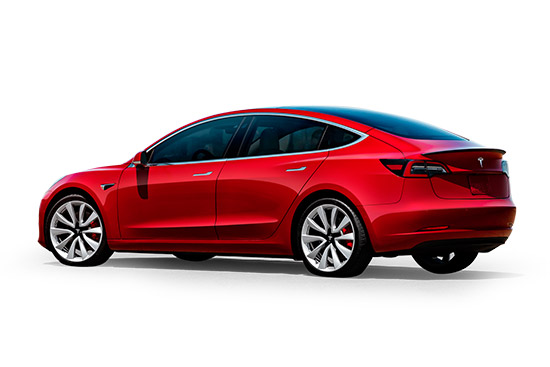
|
尽管蔚来的财务状况不稳定,或许因为投入太高的缘故,但蔚来确实在生产顶级电动汽车。有一天,我乘坐上海往西开的高铁,大约在两个半小时后到达合肥。合肥的国营汽车制造商江淮汽车为蔚来新建了一家工厂。蔚来采取了轻资产的策略,只为江淮制造的汽车和身穿栗色衬衫的工人支付成本。工厂建筑相当引人注目,里面装满了欧洲设计的机器人。我在工厂外的测试跑道上钻进了ES6,也是蔚来刚刚发布对标特斯拉Model 3的车型,然后一脚踩下油门。强烈的推背感把我猛地按在椅背上,不由得喊出声来。蔚来的车可能不招投资者喜欢,开起来确实带劲。 至少在直道上开着非常棒。在实际道路上遇到拐弯之类时,蔚来的操作感略有迟滞。“我认为蔚来的驾驶性能相当好。”查尔斯·黄说,“但还有改进的余地。” |
But for all its financial shakiness—or perhaps because of all that spending—Nio makes an over-the-top electric car. One day I take a high-speed train about two-and-a-half hours west from Shanghai to Hefei, the city in which JAC Motors, a state-owned auto manufacturer, has built a new factory for Nio. In what amounts to a capital-light strategy for the startup, Nio designs the cars and pays JAC for every vehicle that JAC’s maroon-shirted workers roll off the line. The factory is architecturally striking, and it’s chock-full of European-designed robots. Outside, on the factory’s test track, I climb into an ES6, Nio’s just-released answer to Tesla’s Model 3, and floor it. The torque slams me into my seat back and squeezes out of me a whoop. Nio’s cars may be a drag for investors, but they’re a hoot to drive. At least on the straightaway. On the road, with real-life twists and turns, a Nio’s handling can feel a bit squishy. “I think our drivability is quite good,” Huang says, “but we have room to improve.” |
****
|
从原始数据来看,中国电动汽车竞争者之间的差异非常明显。2018年,规模极小的蔚来售出了11348辆电动汽车,净亏损14亿美元。比亚迪售出了53.3万辆汽车,其中近一半为部分电动或纯电动,利润为4.123亿美元。彭博新能源金融的数据显示,汽车行业鼻祖大众在全球销售了1080万辆汽车,其中只有约占0.7%,即79000辆为部分电动或纯电动汽车,净利润达143亿美元。今年早些时候,三家公司的股票均出现了暴跌。 大众于20世纪30年代由纳粹创建,当时是为民众生产汽车的项目。尽管大众一直宣传自己是德国汽车制造商,不断重复“Das Auto”这句广告语,但很久以前就已经开始向中国转移。通过与中国国有制造商成立合资企业,目前大众集团在中国的汽车销量约占总数40%,超过了德国、北美和南美的总和。大众是中国最大的汽车制造商,去年在中国占有19%的市场份额。目前在全球范围内,当然最主要在中国,大众正在努力从为人民群众制造汽车转向制造电动汽车。 大众基本上没有选择。 大众在本地市场欧洲正面临两大严峻的现实。第一个是自作自受:2015年,因为多年来故意制造排放超标的柴油车而导致声誉受损,并且对监管机构反复撒谎。第二个困难在大众内部的一些人看来是第一个问题的后续,主要是布鲁塞尔监管机构施加压力。2018年欧盟要求汽车制造商到2030年将汽车的碳排放量削减37.5%。在碳战争中,大众的目标极为艰巨,由于道路上有庞大数量的大众汽车,占到了全球碳排放量的1%。 |
Raw numbers drive home the differences among China’s EV contenders. In 2018, tiny Nio sold 11,348 electric cars and posted a net loss of $1.4 billion. Bigger BYD sold 533,000 vehicles, nearly half of them partly or fully electric, and inked a profit of $413.2 million. Automotive granddaddy VW sold 10.8 million vehicles globally—only 79,000, or 0.7%, of them, partly or fully electric, according to Bloomberg New Energy Finance—and it racked up a net profit of $14.3 billion. Stocks in all three companies have swooned from earlier this year. VW was founded by the Nazis in the 1930s as a project to produce automobiles for the masses. But for all VW’s marketing of itself as a German automaker—“Das Auto,” thundered a company slogan—its center of gravity long ago began shifting to China. Working through joint ventures with state-owned Chinese manufacturers, the VW group now sells about 40% of its vehicles in China—more than in Germany, North America, and South America combined. It is China’s biggest automaker, wielding a market share there last year of 19%. Now—globally, but above all in China—VW is attempting to shift from builder merely of the people’s car to builder of the people’s electric car. It essentially has no choice. In Europe, its home market, the company faces two stark realities. The first is its own fault: In 2015, VW’s reputation was shattered by the revelation that its brass had, for years, knowingly built diesel cars that spewed excessive pollution, and then repeatedly lied about it to regulators. The second, which some at VW see as following from the first, comes in the form of a regulatory headlock from Brussels: a 2018 European Union requirement that automakers slash the carbon emissions of their car fleets 37.5% by 2030. VW, in the carbon wars, has an outsize target on its back: It coughs out fully 1% of global carbon emissions owing to the sheer number of cars it puts on the road. |
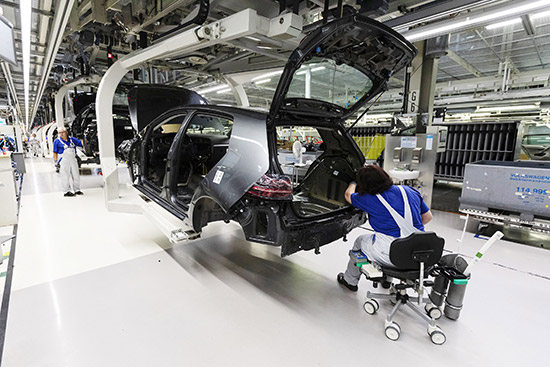
|
在中国,大众面临着另一种监管,推动其进入电动汽车领域。过去几年,中国政府发放了数十亿的补贴支持电动汽车行业,如今正在逐渐取消补贴,转而采取命令手段。中国并未采取加州模式,对汽车征收污染税,而是要求汽车制造商每年销售一定数量的电动汽车,才能够抵消燃油汽车的销售,要么就向更环保的竞争对手购买配额。 简而言之,中国政府的政策正在从胡萝卜变为大棒。大众中国区的负责人冯思翰预测,通过减少更多电动汽车销量,中国将强推规模经济,几年内令电动汽车的生产成本低于燃油汽车。“很可能在2022年或2023年就能够实现。”他说。 如果真发生,中国政府将开创全球汽车新时代。 2016年年初以来,大众一直在为转型做准备。当时柴油丑闻发生后不久,大众意识到需要可以大规模部署的替代性低碳技术。几年来,大众在少量生产几款燃油车的电动版,特别是基本款两厢车的电动款E-Golf。2016年,大众开始专门为电动汽车设计新平台,即模块化电子驱动设备上试验开发,该平台用德语说是Modularer E-Antriebs-Baukasten(MEB)。 2018年,大众宣布了大胆的新目标:到2050年,该公司将实现碳平衡,不仅在汽车制造方面,更重要的是在汽车使用中也要实现碳平衡。大众汽车的高管仍然在努力想办法实现该承诺,比如如何确保购买电动汽车的人使用清洁的电力能源,而非造成污染的电力,尤其是在电力系统特别依赖煤炭的中国。不过,至少大众自己就得实现相当激进的转变,首先得确保绝大多数的新车均为电动。 |
In China, the company now ¬faces another regulatory prod backing it into the electric-car corner. China’s central government, which for the past several years doled out billions in electric-car subsidies, is pulling back that support and implementing a mandate instead. In what amounts to a polluter’s tax, one modeled on a policy in California, China is requiring that automakers peddle a certain number of electric cars each year to offset their internal-combustion sales—or buy credits from greener rivals. In short, the Chinese government is switching from a carrot to a stick. Wöllenstein, VW’s China head, predicts that, by decreeing more electric-car sales, Beijing will force economies of scale that, within a few years, will make electric cars less expensive than combustion cars to produce. “The lines will probably cross in 2022 or 2023,” he says. If that happens, the Chinese government will have birthed a new global automotive era. VW has been preparing for this shift since early 2016. That was when, in the immediate aftermath of the diesel scandal, the company realized it needed an alternative low-carbon technology that it could deploy at scale. VW had for a few years been manufacturing small numbers of electric versions of a couple of its combustion models, notably the E-Golf, a variant of its basic hatchback. But in 2016, VW started work on a new platform designed specifically for electric vehicles—the modular E-drive kit, or in German, Modularer E-Antriebs-Baukasten (MEB). In 2018, the company announced an audacious new target: It will be carbon-neutral by 2050—not just in manufacturing its cars but also, far more significantly, in the operation of its cars over their lifetime on the road. VW executives are still trying to figure out how to meet this promise—how, for instance, to ensure that those who buy its electric cars charge them with clean, rather than dirty, electricity, particularly in China, where the power system is especially coal-dependent. At a minimum, though, the company will need to do something pretty radical: It will have to make the vast majority of its new-vehicle lineup electric. |
****
|
很难夸大该转型多么具有史诗意义。所以我决定前往沃尔夫斯堡见一见转型的负责人。 托马斯·乌布利希在30年前进入大众工作,当时是汽车修理工。如今他剃光了头,体格强壮,仍然保留着一线工人的形象。但在实际工作中,他穿着蓝色西装,和其他董事会成员坐在大众汽车的行政大楼里下达指令。看起来乌布利希很喜欢匀速前进。在燃油的大众GTI里就像第六档。现在乌布利希开的当然是电动版高尔夫,他在沃尔夫斯堡的一家喷漆店把车改成了酷炫的哑光白,还让我试开了一下,车内有一股他最喜欢的小雪茄牌子Clubmaster味道。我按下点火按钮时,传出了史密斯飞船乐队的经典老歌“Cryin”。 我们在他的会议室里聊天时,乌布利希脱下夹克,像笼中的狮子一样踱步,喝掉了一小杯意式咖啡。我们交谈的时间不长,但他透露了我花好几秒才反应过来的事情。考虑到设计新车所需的准备时间,在未来几年内,大众将开始开发最后一款使用内燃发动机的汽车,用行话简称是ICE。乌布利希告诉我,他希望与负责该项目的工程师达成默契:“先生们,好好干,好好做,一定要好好干好好做,因为这是你们最后一次在燃油平台上开发新车了。” 大众最近发布了一系列关于电动汽车发展的统计数据,一项数据比一项大胆。到明年,大众将开始在MEB平台上生产两款车:一款让人很容易联想到高尔夫的两厢车,称为ID.3;另一款是小型SUV,叫ID.crozz。到2022年,8家工厂都将生产MEB汽车:两家在中国,包括在上海的工厂;一家在美国查塔努加;还有5家在欧洲。到2023年,公司将斥资330亿美元推动电动汽车转型。到2028年,70种车型将累计售出2200万辆电动汽车。 |
It’s hard to overstate the epic nature of this shift. Which is why I went to Wolfsburg to meet the man directing it. Thomas Ulbrich started at VW three decades ago as an auto mechanic. Today, with his shaved head and powerful build, he retains much of that factory-floor persona. But now he wears a blue suit and commands an office alongside other board members high up in Volkswagen’s executive tower. Ulbrich appears to operate at one speed. In a conventionally powered VW GTI, it would be sixth gear. Now, of course, Ulbrich drives an E-Golf, one he had the Wolfsburg paint shop coat in a particularly badass matte white. He lets me drive it; the interior smells of his favorite cigarillo brand, Clubmaster, and, when I press the power button, the speakers start pumping out “Cryin’,” by Aerosmith. As we talk in his conference room, Ulbrich sheds his jacket, paces like a caged lion, and downs an espresso from a demitasse. Not long into our conversation, he lets loose a fact that takes me a good couple of seconds to process. Given the lead time required to design a new car, VW will begin developing, in the next few years, what will be its last-ever vehicle powered by an internal-combustion engine—in the lingo, an ICE. Ulbrich tells me he expects to have the following heart-to-heart with engineers who will lead that effort: “Gentlemen, do it good, do it right—do it really good and right—because it is the last time you are starting to develop an ICE platform.” VW has recently let fly a flurry of statistics about its electric-car intentions, each brasher than the last. By next year, it will begin producing two cars on the MEB platform: a hatchback evocative of the Golf, called the ID.3, and a small SUV, the ID.Crozz. By 2022, it will be building MEB cars at eight factories: two in China, including the one in Shanghai; one in the U.S., in Chattanooga; and five in Europe. By 2023, it will have spent $33 billion on its electric-vehicle transition. By 2028, it will have sold a cumulative 22 million electric vehicles across 70 different models. |
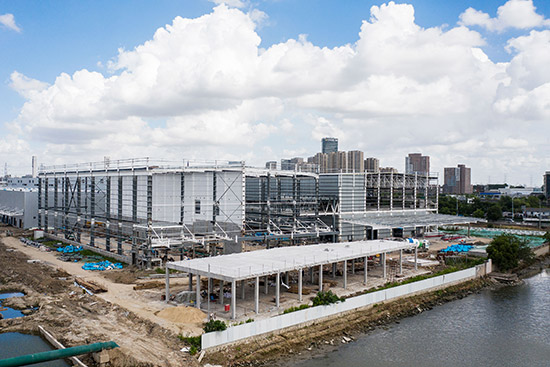
|
第一批MEB生产的汽车将于11月开始下线。地点是德国东部萨克森地区的一家工厂,在风景如画的小镇茨威考,也是汽车制造业的大本营。我去探访了一番。 历史上,茨威考工厂每年生产30万辆高尔夫、高尔夫跑车,还有帕萨特,以及约10000台大众旗下的豪华品牌宾利和兰博基尼的车身。但是在接下来的两年里,除了宾利和兰博基尼的车身,工厂将减少燃油汽车的产量,并增加电动汽车的产量。 大众正花费13亿美元改造茨威考工厂,用于生产电动汽车。大约40%的钱投向车身工厂。为了确保碰撞中保护电池,电动汽车车身将比燃油汽车重约210磅,要做得更坚固。ID.3将有约6000个焊接点,高尔夫只有约5200个。 焊接点增加并不是唯一的难题。燃油车中有各种各样的电子大脑,被称为电子控制单元,或简称ECU,某种程度上彼此独立工作。但在电动汽车中,电子设备对汽车动力更为关键,ECU之间的联系更为紧密。这意味着工厂工人必须学习全新的装配方法。这就是为什么世界各地大众工厂的工人都在前往茨威考加紧学习,为即将上马MEB生产线做准备。 规模最大的队伍之一来自于中国。我在参观茨威考装配线时遇到了一位上海工人何龙(音译)。他已经在大众-上汽合资的工厂工作24年,很快将回去协助MEB生产。我问他制造电动汽车和传统汽车有什么不同。“ECU太多了。”他回答说。 如果大众想追上中国竞争对手,何龙和他的中国同事就要确保出色完成制造新款电动汽车的任务,这将对大众的全球布局至关重要。 大众的高管表示,对中国的几家大型电动汽车制造商表示钦佩,其中也包括比亚迪。他们说,至于蔚来之类的初创企业能不能造出可靠的汽车,要由时间证明。大众中国的首席执行官冯思翰建议,打算开着蔚来走远途的话,要准备好中国版的Uber叫车软件:“这么说吧,手机和滴滴都得确保没有问题才行。”但大众显然在关注蔚来。当茨威考工厂的负责人向我展示大众推进电动汽车的情况时,一张介绍市场竞争的幻灯片上特斯拉的旁边就写着蔚来。冯思翰指出,蔚来之类的初创公司生产的汽车上有很多小装置,是一种“间接威胁”,主要是因为会影响“客户对标准配置的看法”。类似竞争正日益激烈。大众已经跟制造蔚来汽车的中国公司江淮成立合资企业。根据协议,大众和江淮将推出面向中国年轻消费者的入门级电动汽车。工厂位于合肥,跟蔚来工厂在同一座城市。 大众的电动汽车总裁乌布利希曾经在中国工作过7年,过程中,他对中国创新的速度和成熟度产生了深刻的敬意。直到今天,他的办公室仍然装饰着中国艺术品。他指出,过去如果说起中国电动汽车制造商能够超过强大的德国巨头,许多同事都会嗤之以鼻。但他表示,“嘲笑只能针对第一代汽车。”乌布利希通常每个月都要在中国呆几天,他和大众品牌管理委员会的同事每年还要去中国两次,推动新的本地竞争策略。如今,他们评估中国的竞争对手时,沃尔夫斯堡已经几乎没有人笑得出来了。(财富中文网) 本文另一版本登载于《财富》杂志2019年9月刊,标题为《电动汽车热潮:汽车行业押注中国》。 译者:Charlie 审校:夏林 |
The first MEB production cars will start rolling off the assembly line in November. They will be built in a plant in eastern Germany’s Saxony region, an auto-manufacturing stronghold, in a picturesque town called Zwickau. I went for a look. The Zwickau plant historically produced, every year, 300,000 Golfs, Golf Sportwagons, and Passats, along with about 10,000 auto bodies for Bentley and Lamborghini, luxury brands that VW owns. But, over the next two years, it will ramp down production of combustion cars—except for the Bentley and Lamborghini bodies—and ramp up production of electric vehicles. VW is spending $1.3 billion to renovate the Zwickau factory for electric-car production. Some 40% of that money will go to the body shop. To protect the battery in a crash, the electric car’s body will be about 210 pounds heavier, in order to be stiffer, than a combustion car’s. The ID.3 will have about 6,000 welds instead of the Golf’s approximately 5,200. Added welds aren’t the only headache. In a combustion car, the various electronic brains, known as electronic control units, or ECUs, work somewhat independently of one another. But in an electric car, in which the electronics are more fundamental to powering the vehicle, the ECUs are more closely linked. That means factory workers have to learn a new way of assembling them. And that’s why VW workers from factories around the world that soon will start producing MEB cars are parachuting into Zwickau to get up to speed. One of the biggest contingents is coming from China. I meet one Shanghai worker, He Long, as I’m touring the Zwickau assembly line. He has worked for 24 years in the Shanghai factory complex run by the VW-SAIC joint venture. Soon he will go back to help implement MEB production there. I ask him how making an electric car will differ from making a conventional one. “Too many ECUs,” he says. It will be crucial to VW’s global fortunes that He and his colleagues do a bang-up job cranking out the new electric models in China if Volkswagen wants to keep up with its Chinese rivals. VW executives profess admiration for a handful of large Chinese electric-car makers, among them BYD. They say time will tell whether startups like Nio can make reliable cars. Wöllenstein, the VW China chief, suggests anyone attempting to drive a Nio a long distance be prepared to call the Chinese equivalent of an Uber: “Let’s say, keep your mobile phone and a DiDi app” ready. But VW clearly is eyeing Nio. When the head of the Zwickau plant shows me a presentation on VW’s electric-car push, it has Nio’s logo pasted alongside Tesla’s on a slide underscoring market competition. And Wöllenstein notes the gadget-laden cars from startups like Nio are an “indirect threat,” changing “customers’ perceptions of what is a must-have.” That competition is getting increasingly close. VW has inked a joint venture with JAC, the Chinese company that’s building Nio’s cars, under which VW and JAC will launch an entry-level electric-car brand aimed at young Chinese consumers. Its factory is to be built in Hefei, the same city that’s home to the Nio production plant. Ulbrich, the electric-car chief, spent seven years working in China for VW—and in the process, developed a deep respect for the speed and sophistication of Chinese innovation. To this day, his office is decorated with Chinese art. He notes that many of his colleagues used to chuckle at the thought of Chinese electric-car makers outpacing the mighty German behemoth. But “the smile,” he says, “was for the first generation of these cars.” Ulbrich typically spends at least a few days each month in China, and he and his colleagues on the VW brand’s management board fly there twice yearly to drive the latest local competition. These days, when they assess their Chinese rivals, few in Wolfsburg are laughing. A version of this article appears in the September 2019 issue of Fortune with the headline “Electric Gold Rush: The Auto Industry Charges Into China.” |













